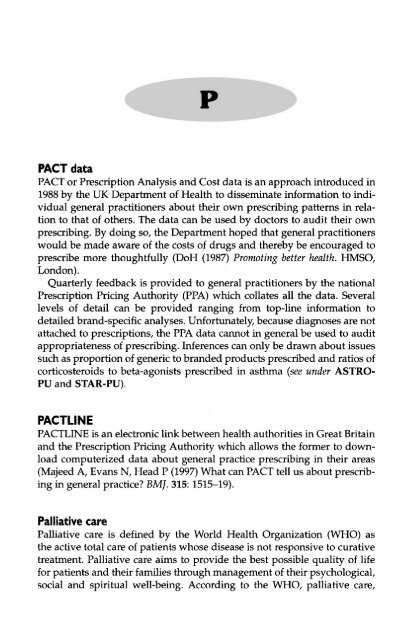Dictionary of Evidence-based Medicine.pdf
Dictionary of Evidence-based Medicine.pdf
Dictionary of Evidence-based Medicine.pdf
Create successful ePaper yourself
Turn your PDF publications into a flip-book with our unique Google optimized e-Paper software.
P<br />
PACT data<br />
PACT or Prescription Analysis and Cost data is an approach introduced in<br />
1988 by the UK Department <strong>of</strong> Health to disseminate information to individual<br />
general practitioners about their own prescribing patterns in relation<br />
to that <strong>of</strong> others. The data can be used by doctors to audit their own<br />
prescribing. By doing so, the Department hoped that general practitioners<br />
would be made aware <strong>of</strong> the costs <strong>of</strong> drugs and thereby be encouraged to<br />
prescribe more thoughtfully (DoH (1987) Promoting better health. HMSO,<br />
London).<br />
Quarterly feedback is provided to general practitioners by the national<br />
Prescription Pricing Authority (PPA) which collates all the data. Several<br />
levels <strong>of</strong> detail can be provided ranging from top-line information to<br />
detailed brand-specific analyses. Unfortunately, because diagnoses are not<br />
attached to prescriptions, the PPA data cannot in general be used to audit<br />
appropriateness <strong>of</strong> prescribing. Inferences can only be drawn about issues<br />
such as proportion <strong>of</strong> generic to branded products prescribed and ratios <strong>of</strong><br />
corticosteroids to beta-agonists prescribed in asthma (see under ASTRO-<br />
PU and STAR-PU).<br />
PACTLINE<br />
PACTLINE is an electronic link between health authorities in Great Britain<br />
and the Prescription Pricing Authority which allows the former to download<br />
computerized data about general practice prescribing in their areas<br />
(Majeed A, Evans N, Head P (1997) What can PACT tell us about prescribing<br />
in general practice BMJ. 315: 1515-19).<br />
Palliative care<br />
Palliative care is defined by the World Health Organization (WHO) as<br />
the active total care <strong>of</strong> patients whose disease is not responsive to curative<br />
treatment. Palliative care aims to provide the best possible quality <strong>of</strong> life<br />
for patients and their families through management <strong>of</strong> their psychological,<br />
social and spiritual well-being. According to the WHO, palliative care,










